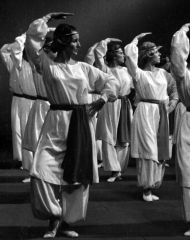Gurdjieff
International Review
Spring 2002 Issue, Vol. V No. 1
A “Teacher of Dancing”
Introduction
by Ellen Dooling Draper
Although we have been gathering articles about movements since we established the Gurdjieff International Review in 1996, this is the first time we have provided coverage of this vital aspect of Gurdjieff’s teaching.
The views expressed in this collection are those of the individual authors and do not necessarily reflect the views of any specific organization.
Our guest editor, Ellen Dooling Draper, is a member of the Gurdjieff Foundation of New York and a previous editor with Parabola Magazine.
Part I: Gurdjieff on Movements
by G. I. Gurdjieff
Gurdjieff wrote sparingly about movements. The following excerpts taken from Beelzebub’s Tales to His Grandson, Meetings with Remarkable Men and Views from the Real World are reprinted by the kind permission of Triangle Editions, Inc.
Part II: Historical Perspective
Descriptions of the practice and performance of Gurdjieff’s Movements during his lifetime, between 1920 and 1949.
Gurdjieff’s Temple Dances
by John G. Bennett
John G. Bennett describes the “Temple Dances” Gurdjieff was teaching his pupils in Constantinople in 1920 and at the Prieuré in 1923.
Dancing
by Anna Butkovsky-Hewitt
A skilled pianist and dancer, the author describes practicing movements in 1922–1923 as Gurdjieff prepared for public demonstrations in Paris and New York.
Gurdjieff Movements Demonstration
by Louise Welch
Gurdjieff arrives in New York City in February 1924 and presents a movements demonstration at the Neighborhood Playhouse.
The Role of Movement in the Complete Education of Man
by René Daumal
Daumal invites the reader to participate in a movements class lead by Jeanne de Salzmann in the 1930s.
A Talk on the Dances
by C. S. Nott
This excerpt provides C. S. Nott’s vivid account of a 1947 talk in Paris on movements given “by an older pupil who was Gurdjieff’s ‘right hand.’”
A Session of “Movements”
by Pierre Schaeffer
Pierre Schaeffer provides an exceptionally intelligent and heartfelt glimpse of his experience in Gurdjieff’s movements class.
Part III: Contemporary Perspective
Interviews and articles written since Gurdjieff’s death in 1949. The photographs within this section are stills from documentary films of the Movements made from the period 1960–1974 under the direction of Jeanne de Salzmann. They are reproduced by the kind permission of the Institut Gurdjieff, Paris, and the heirs of Jeanne de Salzmann.
Remember Inner Work
by Jessmin Howarth
Jessmin Howarth reviews the history of movements in Gurdjieff’s groups and hints at some discoveries that the practice of the movements can provide.
Sacred Dance
by Pauline de Dampierre
Pauline de Dampierre examines “the ‘science of movement’ which Gurdjieff rediscovered.”
Working with the Movements
by Henri Thomasson
Thomasson shares his struggle after he “experienced a strong rejection of ‘the Movements’, which Gurdjieff insisted on as an essential part of his teaching.”
Dances are for the Mind
by Paul Reynard
Reynard reminds us that the movements invite us to discover a new attentiveness and the opportunity to be both present and open to a new level of consciousness.
The Teacher of Dancing
by Josée de Salzmann
An informed examination of movements is provided and their role as “a language that our intellect cannot understand well but to which the body is sensitive.”
This Entity We Call the Body
by Don Hoyt
The relationship between attention, the body, mind, awareness and movements as a “foundation for the real work of self study and self awaking” is examined.
The Music Has To Like You…
by Mitchell Rudzinski
Mitchell Rudzinski’s advice and comments to his students regarding playing music for the movements is provided from their journals and notebooks.
On Giving up the Luxury of Knowing
by Stafford Ordahl
Ordahl considers the courage to abandon what is known mechanically in favor of trusting an unknown “something else” to be able to play movements music.
Behind the Visible Movement
by Jeanne de Salzmann
The inner movement of attention upon which the outer movement depends.
About This Publication
The Gurdjieff International Review is published by Gurdjieff Electronic Publishing.
Any information or opinions expressed herein do not necessarily reflect the views of the publisher or editors.

“When one’s body revolts against work, fatigue soon sets in; then one must not rest for it would be a victory for the body. When the body desires to rest, don’t; when the mind knows it ought to rest, do so, but one must know and distinguish language of body and mind, and be honest.”
G. I. Gurdjieff
“What exactly are these movements? This question can really be answered only from direct experience of practice of the movements.”
Henri Thomasson
“Occasionally there were public performances. Gurdjieff, in one of his irrepressible freaks, would dress everyone up in Turkish costume. This just had to be borne.”
Pierre Schaeffer
“When one begins to study the Movements, very quickly what becomes obvious is the weakness of the attention: it has no endurance, no defense against the endless motion of the associations, and it is often unconsciously taken away at the very moment that its full concentration would be needed.”
Paul Reynard
“We realise in the movements … that one can collect one’s attention; that one can be awake at times and have an overall sensation of oneself; that a quietness of mind, an awareness of body and an interest of feeling can be brought together and that this results in a more complete state of attentiveness in which the life force is felt and one is sensitive to higher influences. Thus, one has a taste of how life can be lived differently.”
Jessmin Howarth
“You do not realize enough that your attention is your only chance. Without it you can do nothing.”
Jeanne de Salzmann
Copyright © 2002-2019
June 4, 2019
Gurdjieff Electronic Publishing